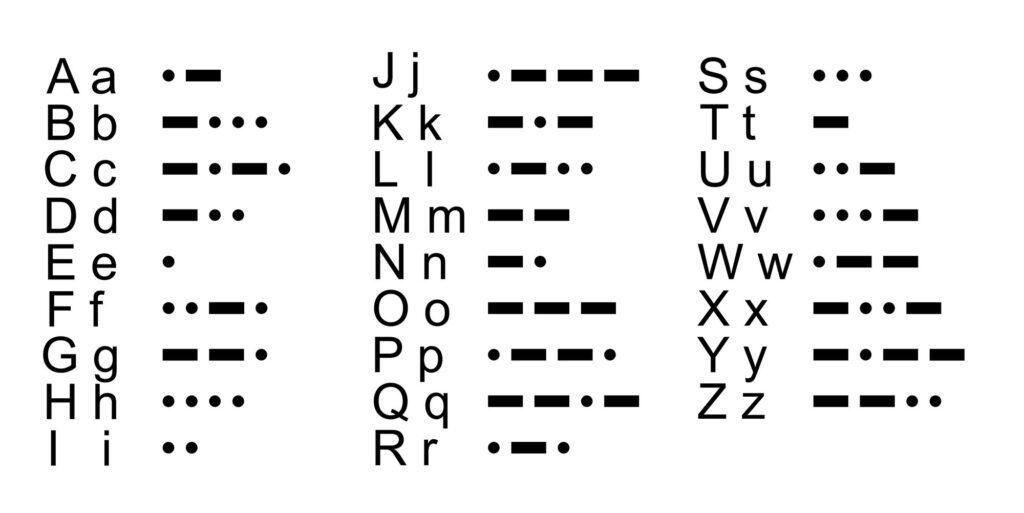MORSE CODE என்றால் என்ன

தமிழ் திரைப்படம் ஒன்றில் அதில் வரும் கதாநாயகன் தனது மனைவி உடன் மோர்ஸ் கோடில் பேசுவதும், கிளைமாக்ஸ் இல் அவர் மனைவி கண் அசைவுகள் மூலம் மோர்ஸ் கோட் செய்து வில்லனின் இருப்பிடத்தை ஹீரோவுக்கு காட்டி கொடுப்பதும் பார்த்து இருப்பீர்கள். அந்த மோர்ஸ் கோட் என்றால் என்ன அதெப்படி கண் அசைவில் எல்லாம் பேச முடியும். என்பதை இப்போது பார்க்கலாம்.
Samuel F.B Morse(Samuel Finley Breese Morse) என்பவரின் பெயரால் அழைக்கப்படுவது தான் இந்த மோர்ஸ். அவர் தான் தந்தியின் கண்டுபிடிப்பாளர். தந்தியில் டக டக என தட்டுவதை பார்த்து இருப்பீர்கள். அது ஏனோ தானோ என்று தட்ட படுவது அல்ல. அதில் ஒரு ஒழுங்கு உண்டு. அது ஒரு பாஷை…தந்தி பாஷை. கணிணிக்கென்று ஒரு பாஷை உண்டு அல்லவா 0 மற்றும் 1 என்று. அதை போல தந்திக்கு ஒரு மொழி உண்டு அது புள்ளி அல்லது கோடு என்ற மொழி. உதாரணமாக மோர்ஸ் கோட் படி A என்றால் ஒரு புள்ளி ஒரு கோடு…
அப்போ AA என்பதை எப்படி எழுதுவீங்க ? புள்ளி கோடு ,புள்ளி கோடு.. சரி தானே..
B என்றால் அதன் பாஷையில் ஒரு கோடு அதை தொடர்ந்து மூணு புள்ளி. (கோடு.புள்ளி.புள்ளி .புள்ளி)இப்ப AB என்று எழுத வேண்டும். முயற்சி செய்து பாருங்கள்…
( ✴ _ _✴ ✴ ✴)இப்படி வரும் சரியா ?
இதில் டிட் டாட் டேஸ் என்பார்கள். டிட் என்றால் கோடு டாட் என்றால் புள்ளி டேஸ் என்பது இரண்டுக்கும் இடையில் உள்ள இடைவெளி. ஒரு கோடு என்பது 3 புள்ளிகள் சேர்ந்த அளவில் இருக்கும். ஒவொரு வார்த்தையும் ஒரு புள்ளி அளவுள்ள டேஸ் அதாவது இடைவெளியால் பிரிக்க பட்டு இருக்கும். மற்றும் இரண்டு வார்த்தைகள் 7 புள்ளி அளவு கொண்ட இடைவெளியால் பிரிக்க பட்டு இருக்கும். இந்த புள்ளி கோடுகள் வெறும் ஆங்கில எழுத்துக்களை மட்டும் அல்ல நம்பர்களையும் குறிக்க பயன்படுகிறது. மோர்ஸில் உள்ள மிக சிறிய எழுத்து என்பது E . (வெறும் ஒரு புள்ளி தான் மோர்ஸ் பாஷையில் E)
சரி எதற்கு இந்த புள்ளி கோடு …இதனால் என்ன வசதி ?
இப்போ ஒரு அறையில் நீங்கள் அடைக்க பட்டு இருக்கிறீர்கள் அடுத்த அறைக்கு உங்களால தொடர்பு கொள்ள முடியாது ஆனால் சுவரில் தட்டினால் அல்லது கீறினால் அடுத்த பக்கம் கேட்கும் என்றால். சுவருக்கு இருபுறமும் உள்ளவர்கள் மோர்ஸ் கோட் தெரிந்தவர்கள் எனில் சுவரில் தட்டுவதை புள்ளி எனவும் கீறுவதை கோடு எனவும் கொண்டு தகவலை பரிமாற முடியும். (கோட் பற்றி தெரியாதவர்களுக்கு சுவரில் மாறி மாறி ஏதோ தட்டுவதும் கீறுவதும் போல தெரியும் )
சரி இப்போ இதை கவனியுங்கள்.. நீங்கள் உயரமான ஒரு கட்டிடத்தில் பெரும் வெள்ளம் அல்லது புயலில் சிக்கி இருக்கிறீர்கள். தூரத்தில் மீட்பு படை கண்ணுக்கு தெரிகிறது ஆனால் கூப்பிடும் எல்லை தாண்டி இருக்கிறார்கள். சைகை செய்யலாம் என்றால் நீங்கள் சிக்கி இருப்பது கும் இருட்டில். என்ன செய்வீர்கள்? இப்போது உங்களிடம் டார்ச் இருந்தால் போதும் நீங்கள் தகவலை பரிமாறலாம். அதாவது டார்ச்சை அணைத்து அணைத்து போட்டால் அது புள்ளி… சில வினாடி நீட்டாக எரிய விட்டால் அது கோடு என்று கணக்கு வைத்து கொண்டு மோர்ஸ் கோடு மூலம் உயிர் ஆபத்தில் இருக்கிறது என்று தெரிவிக்கலாம் .
உலகம் எங்கும் “உயிர் ஆபத்தில் உள்ளது “என்பதை குறிக்க பயன்படுத்த படும் வார்த்தை… “S. O. S .” இதன் முழு அர்த்தம் “SAVE OUR SOLE “
நம்ம மோர்ஸ் கோடில் SOS என்பதை எப்படி தெரிவிக்க வேண்டும் என்று முயற்சி செய்து பாரதால் “புள்ளி புள்ளி புள்ளி..கோடு கோடு கோடு புள்ளி புள்ளி புள்ளி ” என்று வரும்.
(✴✴✴ _ ✴✴✴ )
டார்ச்சை வைத்து இதை சொல்ல முயன்றால் மூன்று முறை குறுகிய இடைவெளியிலும் அதை தொடர்ந்து கொஞ்சம் அதிகம் இடைவெளியில் மூன்று முறையும் டார்ச்சை அணைத்து அணைத்து போட வேண்டும். உங்கள் கையில் ஏதாவது இசை இருந்தால் ..டிக் டிக் டிக் …டீக் டீக் டீக் … டிக் டிக் டிக் என்று ஒலிக்க வேண்டும்.
விமாணிகளுக்கு …ராணுவத்தில்…மீட்பு படையில்…. பல உயிர் ஆபத்தில் … அவசரத்தில் என்று பல இடங்களில் மோர்ஸ் பயன்படுகிறது.
இந்த முறையை தான் தமிழ் திரைபடம் ஒன்றின் செய்திருப்பாா்கள் அந்த படத்தில் செய்தது என்ன என்று இப்போ புரிந்திருக்கும்.
அதாவது கண்ணை சிமிட்டினால் புள்ளி தொடர்ந்து மூடினால் கோடு.








